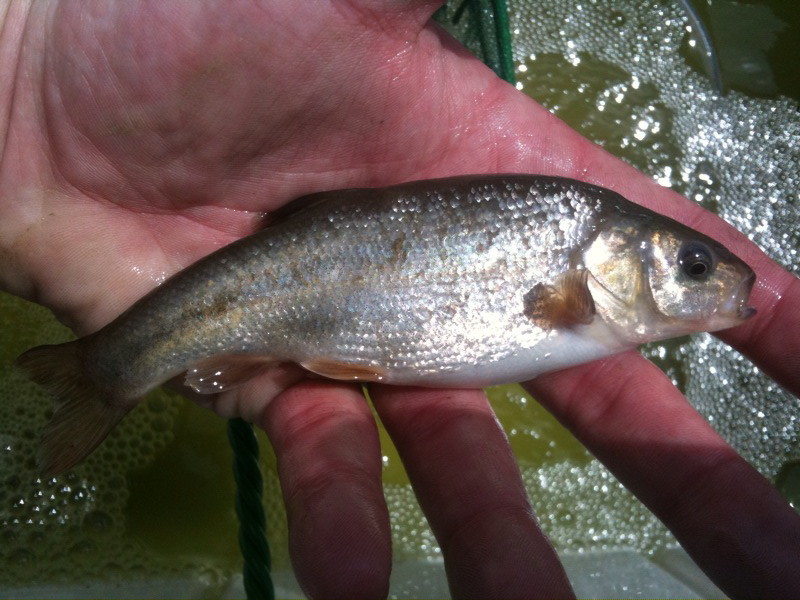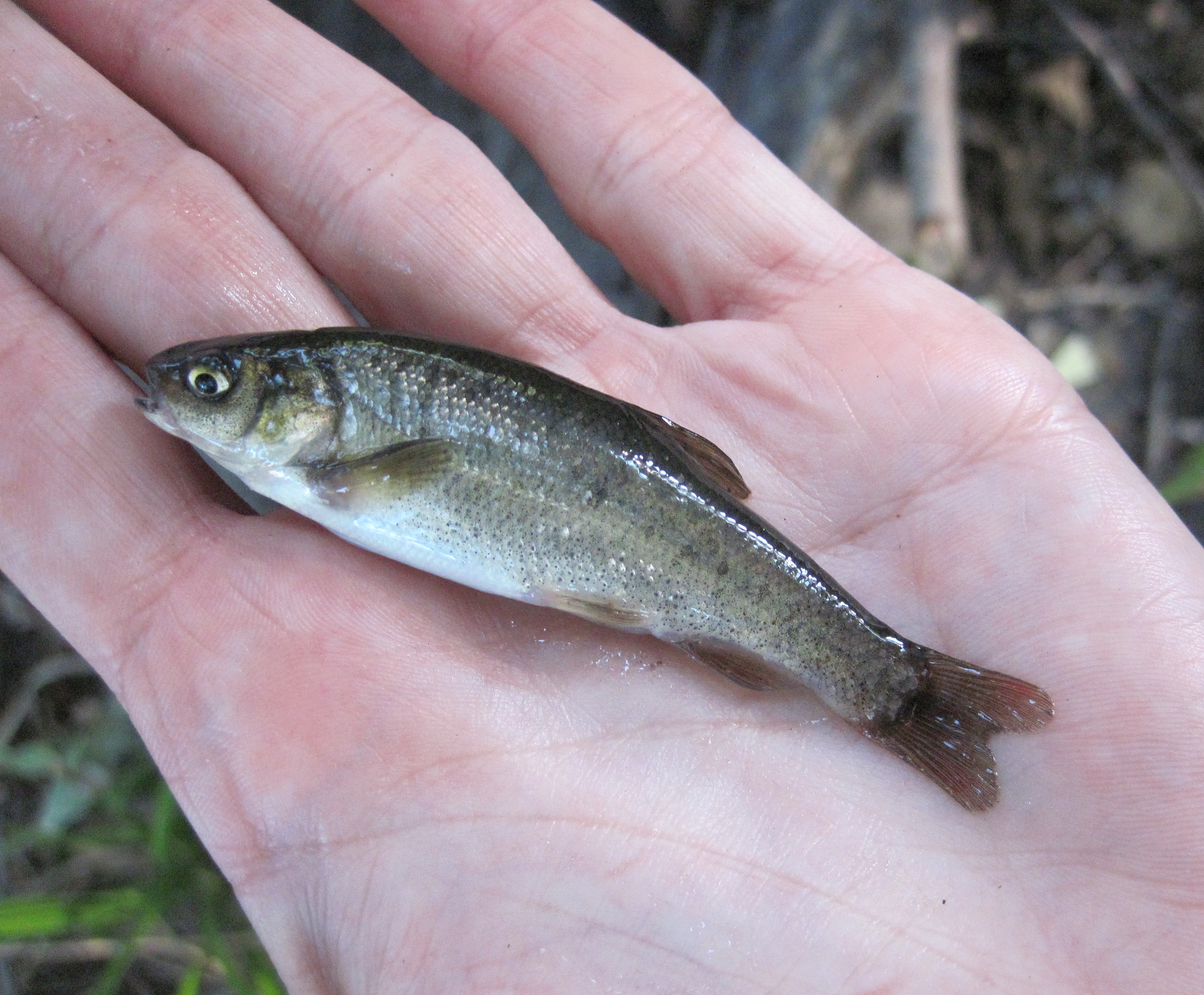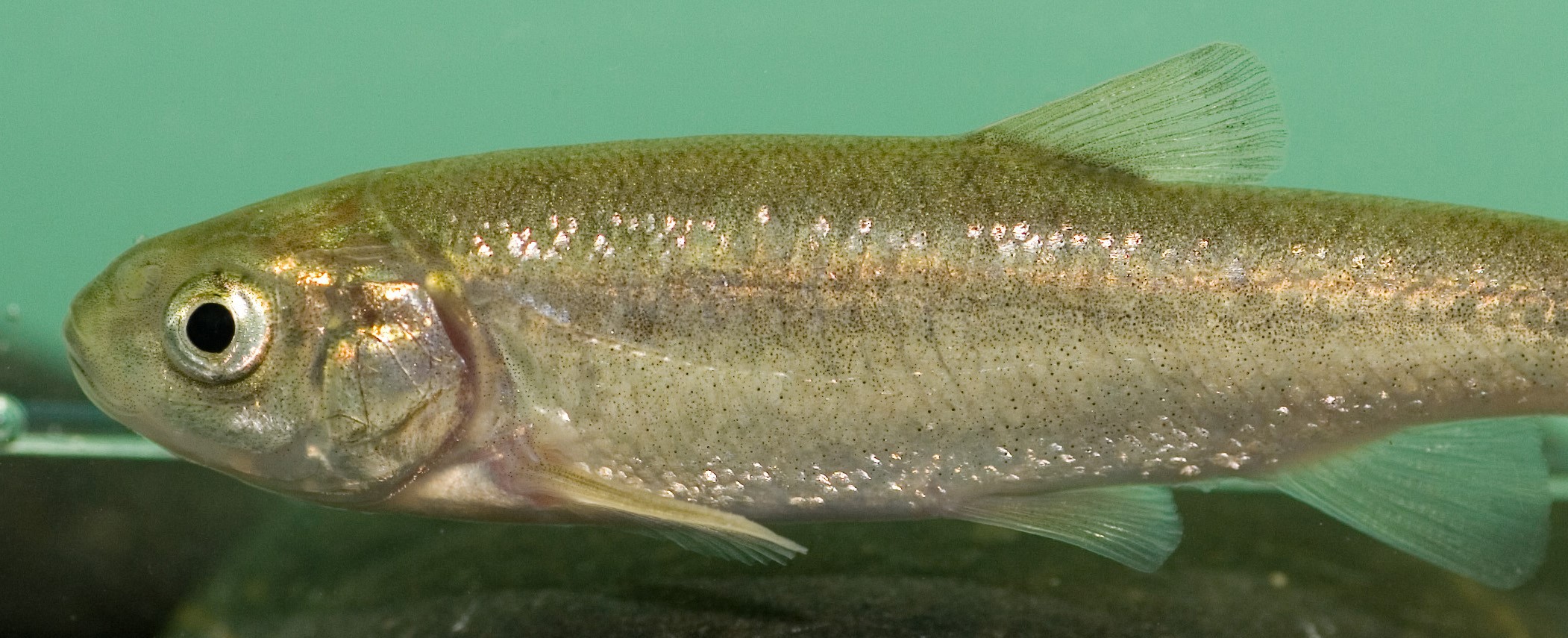Current Distribution Rangewide
Native to the Los Angeles, San Gabriel, San Luis Rey, Santa Ana, and Santa Margarita rivers and to Malibu and San Juan creeks [1 cited from 2]. Absent from much of their native range. Abundant only in the upper Santa Margarita River and its tributary De Luz Creek, Trabuco Creek below O’Neill Park and San Juan Creek (San Juan Creek drainage), Malibu Creek [3] and the West Fork of the upper San Gabriel River below Cogswell Reservoir as of 1991 (CDFG, unpubl. data). Successful introductions into the Santa Ynez, Santa Maria, Cuyama, and Mojave river systems and other smaller coastal streams [4;5 cited from 2]. Scarce occurrences in: Big Tujunga Canyon, Pacoima Creek above Pacoima Reservoir, and in the Sepulveda Flood Control Basin, Los Angeles River drainage; and middle Santa Ana River tributaries between Riverside and the Orange County line [3].
Known Populations in San Diego County
Occurrences found in Santa Margarita River Park and Vista Irrigation District.
List Status
SSC
Habitat Affinities
Found in slow-moving or backwater sections of warm to cool (10-24°C) streams with mud or sand substrates [2]. Does best in lower gradient streams that have largely disappeared [3]. Depths are typically greater than 40 cm [2]. Physiologically adapted to hypoxic conditions and wide temperature fluctuations, conditions common in southern coastal streams [6].
Taxonomy and Genetics
Morphologically and genetically distinct. In the subgenus Temeculina with the closely related Gila purpurea[7]. Able to hybridize with two other cyprinids native to California: Mohave tui chub (Siphatales mohavensis) and California Roach (Lavinia symmetricus) [8;9;13].
Seasonal Activity
Spawn primarily in June and July, however can breed continously from February through August [10 cited from 2,11, and 12].
Life History/Reproduction
Occurs in pools or in quiet edge water at 14 to 22 degrees Celcius. Egg release initiated by the rubbing of the male's snout to the area below the female's pelvic fins. More than one male may fertilize the eggs as they are being laid [10 cited from 2 and 12]. Embryos adhere to plants, rocks, and debris and hatch in 4 days at 24 degrees Celcius. After hatching, fry remain attached to or in the substrate for several days and swim to the surface, presumably to fill the swimbladder, once the yolk sac is absorbed [10 cited from 2 and 11]. Females can begin reproducing after one year. Females grow larger than males after second year. Life expectancy rarely more than 4 years [2;11;12].
Diet and Foraging
True omnivores. Feed on algae, insects, and small crustaceans. Algae made up most (60-80%) of the identified stomach contents [13 cited from 11]. Also feed on roots of a floating water fern (Azolla), whih is generally infested with nematodes [8;5 cited from 14 and 2].
Dispersal
Natural dispersal is typically up- or downstream as conditions and suitable habitat permit. Typically facilitated by flooding events [5 cited from 12]. Dispersal within the mainstem of the Santa Margarita River appeared to increase dramatically after El Nino rains produced flood waters that heavily scoured the vegetation within the drainage, widening channels and reducing channel depths, creating habitat conditions that favor the chub and reduce exotic fish presence [15 cited from 12]. Larvae and juveniles tend to invade standing backwaters and/or disperse downstream from upstream spawning areas within the Santa Ana River [16 cited from 12]. Dispersal within both watersheds is currently limited by several large dams that serve as migration barriers. Many tributaries within each watershed are limited for chub occupation because of artificial or natural upstream migration barriers [15;16; both cited from 12].
Threats
Threatened by habitat degradation, fragmentation, nonnative species [2;11;17], dams, urbanization, mining, transportation, fire, and climate change [17].
Literature Sources
[1] Wells, A. W., J. S. Diana, and C. C. Swift. 1975. Survey of the freshwater fishes and their habitats in the coastal drainages of southern California. Section of Ichthyology, Natural History Museum of Los Angeles County.
[2] Moyle, P. B., R. M. Yoshiyama, J. E. Williams, and E. D. Wikramanayake. 1995. Eulachon. Fish species of special concern in California: 123-127.
[3] Swift, C. C., T. R. Haglund, M. Ruiz, and R. N. Fisher. 1993. The status and distribution of the freshwater fishes of southern California. Bulletin of the Southern California Academy of Sciences 92, no. 3: 101-167.
[4] Miller, R. R. 1968. Records of some native freshwater fishes transplanted into various waters of California, Baja California, and Nevada. California Fish and Game 54, no. 3: 170-179.
[5] Moyle, P. B. 1976. Inland ï¬shes of California. University of California Press. Berkeley, California.
[6] Castleberry, D. T. and J. J. Cech. 1986. Physiological responses of a native and an introduced desert fish to environmental stressors. Ecology67, no. 4: 912-918.
[7] Miller, R. R. 1945. A new cyprinid fish from southern Arizona, and Sonora, Mexico, with the description of a new subgenus of Gila and a review of related species. Copeia no. 2: 104-110.
[8] Greenfield, D. W. and T. Greenfield. 1972. Introgressive hybridization between Gila orcutti and Hesperoleucus symmetricus (Pisces: Cyprinidae) in the Cuyama River Basin, California: I. Meristics, morphometrics and breeding. Copeia: 849-859.
[9] Hubbs, C. L. and R. R. Miller. 1943. Mass hybridization between two genera of cyprinid fishes in the Mohave Desert, California. Michigan Academy of Science, Arts and Letters.
[10] Tres, J. A. 1992. Breeding biology of the arroyo chub. Gila orcutti.
[11] Arroyo Chub Final. Retrieved from: https://nrm.dfg.ca.gov/FileHandler.ashx?DocumentID=104270. Accessed Octoer 20, 2016.
[12] Riverside County Intergrated Project. 2003. Arroyo Chub.
[13] Greenfield, D. W. and G. D. Deckert. 1973. Introgressive hybridization between Gila orcutti and Hesperoleucus symmetricus (Pisces: Cyprinidae) in the Cuyama River Basin, California: II. Ecological aspects. Copeia: 417-427.
[14] NatureServe. 2015. NatureServe Explorer: An online encyclopedia of life [web application]. Version 7.1. NatureServe, Arlington, Virginia. Available from: http://explorer.natureserve.org. Accessed: October 20, 2016.
[15] Fisher, R. N. and C. C. Swift. 1998. Preliminary Survey of the Fish of the Santa Margarita River Watershed, San Diego and Riverside Counties, California.
[16] Swift, C. C. 2001. The Santa Ana sucker in the Santa Ana River: distribution, relative abundance, spawning areas, and the impact of exotic predators. Unpublished report to SAWPA from Larry Munsey International. 94p.
[17] Benjamin, A., B. May, J. O'Brien, and A. J. Finger. 2016. Conservation Genetics of an Urban Desert Fish, the Arroyo Chub.Transactions of the American Fisheries Society 145, no. 2: 277-286.


